immobilizer YAMAHA XV1900A 2012 Owners Manual
[x] Cancel search | Manufacturer: YAMAHA, Model Year: 2012, Model line: XV1900A, Model: YAMAHA XV1900A 2012Pages: 88, PDF Size: 1.91 MB
Page 2 of 88
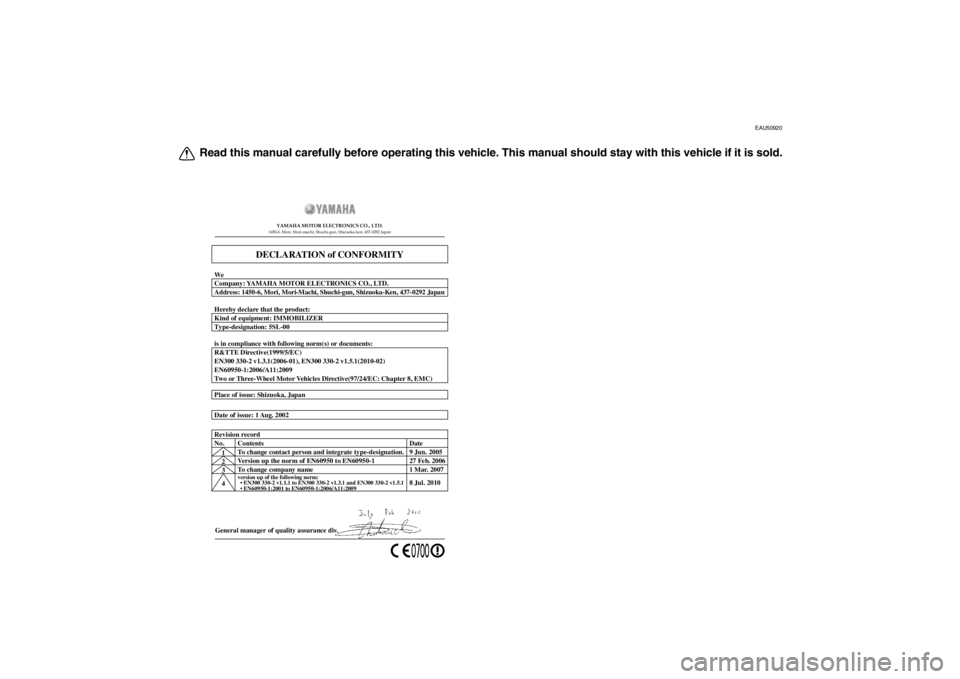
EAU50920
Read this manual carefully before operating this vehicle. This manual should stay with this vehicle if it is sold.
General manager of quality assurance div.
Date of issue: 1 Aug. 2002 Place of issue: Shizuoka, Japan
DECLARATION of CONFORMITY
YAMAHA MOTOR ELECTRONICS CO., LTD.1450-6, Mori, Mori-machi, Shuchi-gun, Shizuoka-ken, 437-0292 Japan
Company: YAMAHA MOTOR ELECTRONICS CO., LTD. We
Address: 1450-6, Mori, Mori-Machi, Shuchi-gun, Shizuoka-Ken, 437-0292 Japan
Kind of equipment: IMMOBILIZER Hereby declare that the product:
Type-designation: 5SL-00
is in compliance with following norm(s) or documents:
R&TTE Directive(1999/5/EC)
EN300 330-2 v1.3.1(2006-01), EN300 330-2 v1.5.1(2010-02)
EN60950-1:2006/A11:2009
Two or Three-Wheel Motor Vehicles Directive(97/24/EC: Chapter 8, EMC)
1
2
3
4 Version up the norm of EN60950 to EN60950-1
To change company name
version up of the following norm:
• EN300 330-2 v1.1.1 to EN300 330-2 v1.3.1 and EN300 330-2 v1.5.1
27 Feb. 2006
1 Mar. 2007
8 Jul. 2010
Revision record
No. Contents
To change contact person and integrate type-designation. Date
9 Jun. 2005
U1CRE1E0.book Page 1 Mond
ay, October 3, 2011 8:45 AM
Page 6 of 88

TABLE OF CONTENTSSAFETY INFORMATION ..................1-1
DESCRIPTION ..................................2-1
Left view ..........................................2-1
Right view ........................................2-2
Controls and instrume nts.................2-3
INSTRUMENT AND CONTROL
FUNCTIONS .......................................3-1
Immobilizer system .... .....................3-1
Main switch/steering lock ................3-2
Indicator lights and warning lights ............................................3-4
Multi-function meter unit .................3-5
Anti-theft alarm (optional) .............3-10
Handlebar switches ......................3-10
Clutch lever ...................................3-12
Shift pedal .... ............................ .....3-12
Brake lever ...................................3-12
Brake pedal ..................................3-13
Fuel tank cap ................................3-13
Fuel ...............................................3-14
Fuel tank breather/overflow
hose ..........................................3-15
Catalytic converter ........................3-15
Rider seat .....................................3-16
Helmet holder ...............................3-17
Adjusting the shock absorber
assembly ...................................3-18
EXUP system ...............................3-19
Sidestand ......................................3-20 Ignition circuit cut-
off system ........ 3-20
Auxiliary DC connector ................. 3-22
FOR YOUR SAFETY –
PRE-OPERATION CHECKS ............. 4-1
OPERATION AND IMPORTANT
RIDING POINTS ................................. 5-1
Starting the engine ......................... 5-1
Shifting ........................................... 5-2
Tips for reducing fuel consumption ............................... 5-3
Engine break-in .............................. 5-3
Parking ........................................... 5-4
PERIODIC MAINTENANCE AND
ADJUSTMENT ................................... 6-1
Owner’s tool kit ............................... 6-2
Periodic maintenance chart for the emission control system ............. 6-3
General maintenance and lubrication chart .......................... 6-4
Checking the spark plugs ............... 6-8
Engine oil and oil filter cartridge ..... 6-9
Transfer case oil ........................... 6-12
Air filter element ........................... 6-12
Checking the throttle grip free play ........................................... 6-13
Valve clearance ............................ 6-13
Tires ............................................. 6-13
Cast wheels .................................. 6-15 Clutch lever .................................. 6-15
Checking the brake lever free
play ........................................... 6-16
Brake light switches ..................... 6-16
Checking the front and rear brake
pads .......................................... 6-17
Checking the brake and clutch fluid levels ................................. 6-17
Changing the brake and clutch fluids ......................................... 6-19
Drive belt slack ............................ 6-19
Checking and lubricating the cables ....................................... 6-20
Checking and lubricating the
throttle grip and cable ............... 6-20
Checking and lubricating the brake and shift pedals .............. 6-21
Checking and lubricating the brake and clutch levers ............ 6-21
Checking and lubricating the
sidestand .................................. 6-22
Lubricating the rear suspension ... 6-22
Checking the front fork ................. 6-23
Checking the steering .................. 6-23
Checking the wheel bearings ....... 6-24
Battery ......................................... 6-24
Replacing the fuses ..................... 6-25
Replacing a headlight bulb .......... 6-26
Tail/brake light ............................. 6-29
Replacing a turn signal light bulb ........................................... 6-29U1CRE1E0.book Page 1 Mond ay, October 3, 2011 8:45 AM
Page 16 of 88
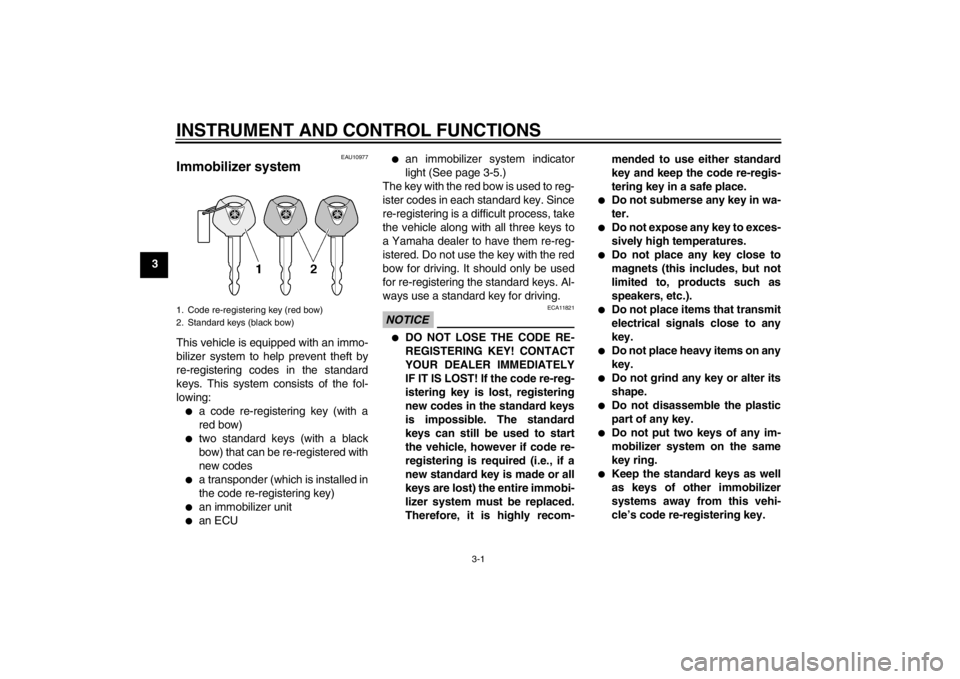
INSTRUMENT AND CONTROL FUNCTIONS
3-1
3
EAU10977
Immobilizer system This vehicle is equipped with an immo-
bilizer system to help prevent theft by
re-registering codes in the standard
keys. This system consists of the fol-
lowing:●
a code re-registering key (with a
red bow)
●
two standard keys (with a black
bow) that can be re-registered with
new codes
●
a transponder (which is installed in
the code re-registering key)
●
an immobilizer unit
●
an ECU
●
an immobilizer system indicator
light (See page 3-5.)
The key with the red bow is used to reg-
ister codes in each standard key. Since
re-registering is a difficult process, take
the vehicle along with all three keys to
a Yamaha dealer to have them re-reg-
istered. Do not use the key with the red
bow for driving. It should only be used
for re-registering the standard keys. Al-
ways use a standard key for driving.
NOTICE
ECA11821
●
DO NOT LOSE THE CODE RE-
REGISTERING KEY! CONTACT
YOUR DEALER IMMEDIATELY
IF IT IS LOST! If the code re-reg-
istering key is lost, registering
new codes in the standard keys
is impossible. The standard
keys can still be used to start
the vehicle, however if code re-
registering is required (i.e., if a
new standard key is made or all
keys are lost) the entire immobi-
lizer system must be replaced.
Therefore, it is highly recom- mended to use either standard
key and keep the code re-regis-
tering key in a safe place.
●
Do not submerse any key in wa-
ter.
●
Do not expose any key to exces-
sively high temperatures.
●
Do not place any key close to
magnets (this includes, but not
limited to, products such as
speakers, etc.).
●
Do not place items that transmit
electrical signals close to any
key.
●
Do not place heavy items on any
key.
●
Do not grind any key or alter its
shape.
●
Do not disassemble the plastic
part of any key.
●
Do not put two keys of any im-
mobilizer system on the same
key ring.
●
Keep the standard keys as well
as keys of other immobilizer
systems away from this vehi-
cle’s code re-registering key.
1. Code re-registering key (red bow)
2. Standard keys (black bow)U1CRE1E0.book Page 1 Mond
ay, October 3, 2011 8:45 AM
Page 17 of 88
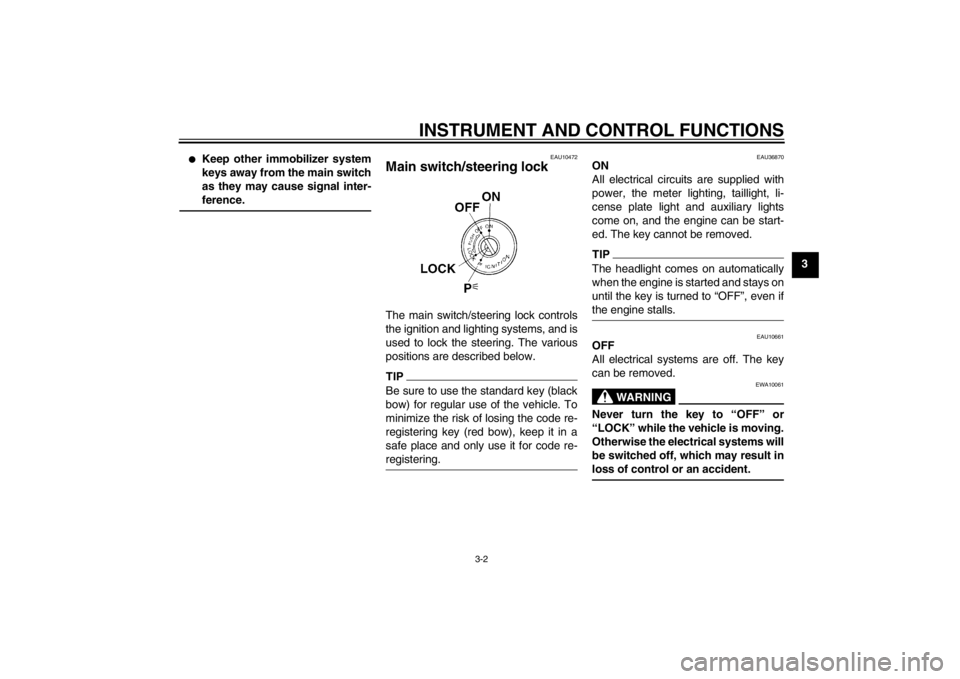
INSTRUMENT AND CONTROL FUNCTIONS
3-2
3
●
Keep other immobilizer system
keys away from the main switch
as they may cause signal inter-
ference.
EAU10472
Main switch/steering lock The main switch/steering lock controls
the ignition and lighting systems, and is
used to lock the steering. The various
positions are described below.TIPBe sure to use the standard key (black
bow) for regular use of the vehicle. To
minimize the risk of losing the code re-
registering key (red bow), keep it in a
safe place and only use it for code re-
registering.
EAU36870
ON
All electrical circuits are supplied with
power, the meter lighting, taillight, li-
cense plate light and auxiliary lights
come on, and the engine can be start-
ed. The key cannot be removed.TIPThe headlight comes on automatically
when the engine is started and stays on
until the key is turned to “OFF”, even if
the engine stalls.
EAU10661
OFF
All electrical syst ems are off. The key
can be removed.
WARNING
EWA10061
Never turn the key to “OFF” or
“LOCK” while the vehicle is moving.
Otherwise the electrical systems will
be switched off, which may result in
loss of control or an accident.
U1CRE1E0.book Page 2 Mond ay, October 3, 2011 8:45 AM
Page 19 of 88
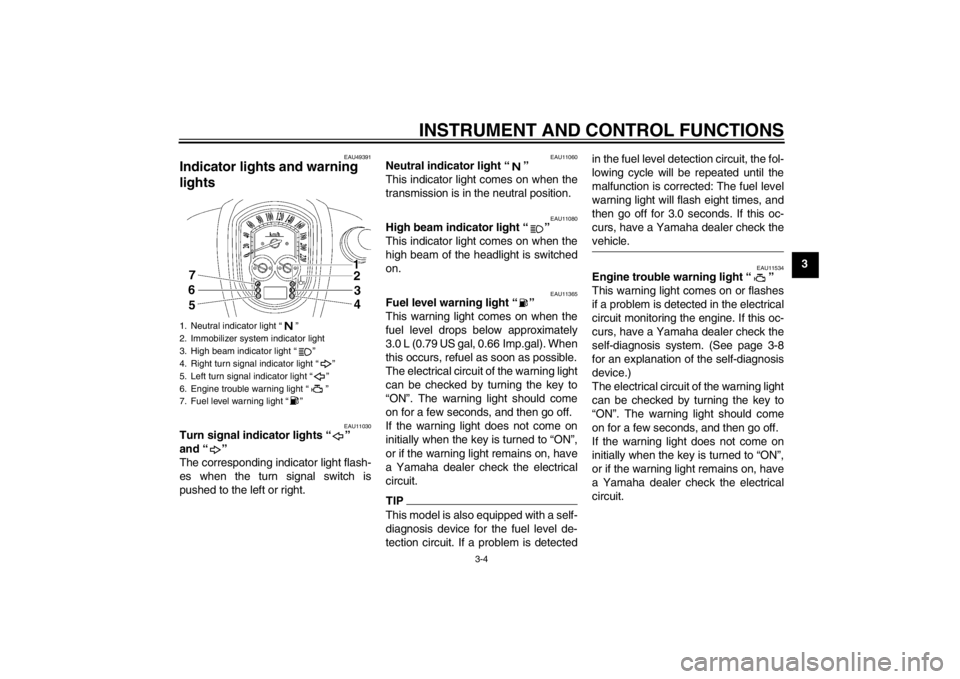
INSTRUMENT AND CONTROL FUNCTIONS
3-4
3
EAU49391
Indicator lights and warning
lights
EAU11030
Turn signal indicator lights “ ”
and “ ”
The corresponding indicator light flash-
es when the turn signal switch is
pushed to the left or right.
EAU11060
Neutral indicator light “ ”
This indicator light comes on when the
transmission is in the neutral position.
EAU11080
High beam indicator light “ ”
This indicator light comes on when the
high beam of the headlight is switched
on.
EAU11365
Fuel level warning light “ ”
This warning light comes on when the
fuel level drops below approximately
3.0 L (0.79 US gal, 0.66 Imp.gal). When
this occurs, refuel as soon as possible.
The electrical circuit of the warning light
can be checked by turning the key to
“ON”. The warning light should come
on for a few seconds, and then go off.
If the warning light does not come on
initially when the key is turned to “ON”,
or if the warning light remains on, have
a Yamaha dealer check the electrical
circuit.TIPThis model is also equipped with a self-
diagnosis device for the fuel level de-
tection circuit. If a problem is detected in the fuel level detection circuit, the fol-
lowing cycle will be repeated until the
malfunction is corrected: The fuel level
warning light will flash eight times, and
then go off for 3.0 seconds. If this oc-
curs, have a Yamaha dealer check the
vehicle.
EAU11534
Engine trouble warning light “ ”
This warning light comes on or flashes
if a problem is detected in the electrical
circuit monitoring the engine. If this oc-
curs, have a Yamaha dealer check the
self-diagnosis system. (See page 3-8
for an explanation of the self-diagnosis
device.)
The electrical circuit of the warning light
can be checked by turning the key to
“ON”. The warning light should come
on for a few seconds, and then go off.
If the warning light does not come on
initially when the key is turned to “ON”,
or if the warning light remains on, have
a Yamaha dealer check the electrical
circuit.
1. Neutral indicator light “ ”
2. Immobilizer system indicator light
3. High beam indicator light “ ”
4. Right turn signal indicator light “ ”
5. Left turn signal indicator light “ ”
6. Engine trouble warning light “ ”
7. Fuel level warning light “ ”
U1CRE1E0.book Page 4 Mond
ay, October 3, 2011 8:45 AM
Page 20 of 88
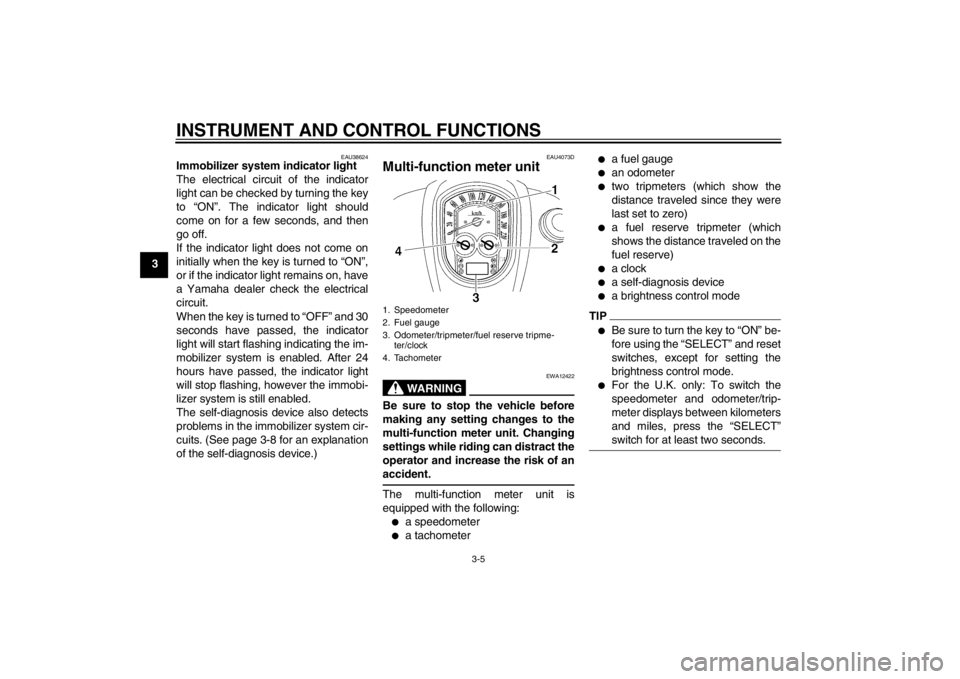
INSTRUMENT AND CONTROL FUNCTIONS
3-5
3
EAU38624
Immobilizer system indicator light
The electrical circuit of the indicator
light can be checked by turning the key
to “ON”. The indicator light should
come on for a few seconds, and then
go off.
If the indicator light does not come on
initially when the key is turned to “ON”,
or if the indicator light remains on, have
a Yamaha dealer check the electrical
circuit.
When the key is turned to “OFF” and 30
seconds have passed, the indicator
light will start flashing indicating the im-
mobilizer system is enabled. After 24
hours have passed, the indicator light
will stop flashing, however the immobi-
lizer system is still enabled.
The self-diagnosis device also detects
problems in the immobilizer system cir-
cuits. (See page 3-8 for an explanation
of the self-diagnosis device.)
EAU4073D
Multi-function meter unit
WARNING
EWA12422
Be sure to stop the vehicle before
making any setting changes to the
multi-function meter unit. Changing
settings while riding can distract the
operator and increase the risk of an
accident.The multi-function meter unit is
equipped with the following:●
a speedometer
●
a tachometer
●
a fuel gauge
●
an odometer
●
two tripmeters (which show the
distance traveled since they were
last set to zero)
●
a fuel reserve tripmeter (which
shows the distance traveled on the
fuel reserve)
●
a clock
●
a self-diagnosis device
●
a brightness control mode
TIP●
Be sure to turn the key to “ON” be-
fore using the “SELECT” and reset
switches, except for setting the
brightness control mode.
●
For the U.K. only: To switch the
speedometer and odometer/trip-
meter displays between kilometers
and miles, press the “SELECT”
switch for at least two seconds.
1. Speedometer
2. Fuel gauge
3. Odometer/tripmeter/fuel reserve tripme-ter/clock
4. Tachometer
U1CRE1E0.book Page 5 Mond ay, October 3, 2011 8:45 AM
Page 23 of 88
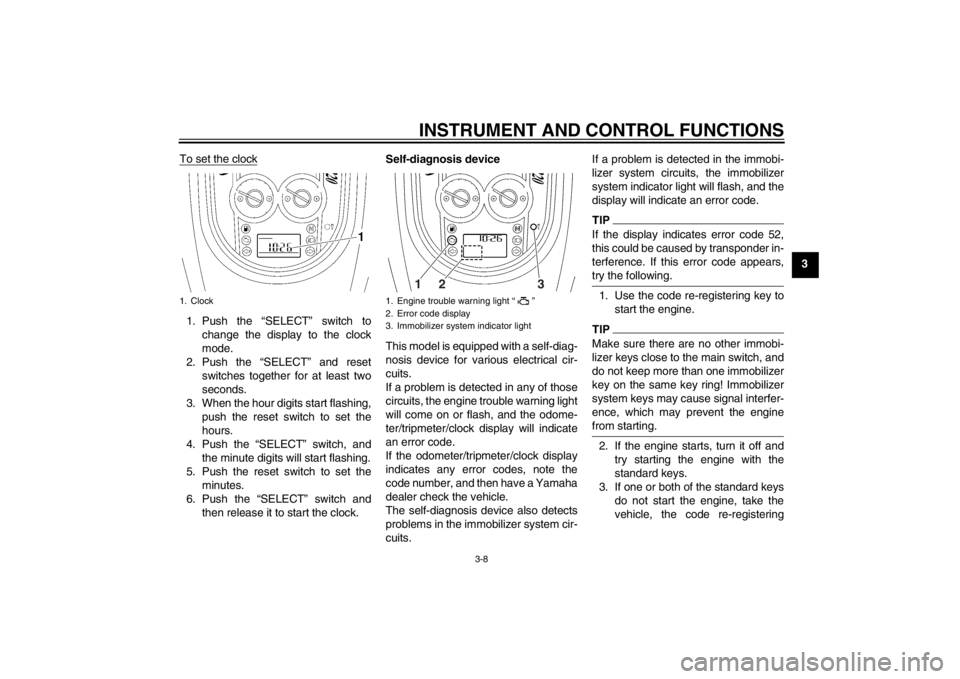
INSTRUMENT AND CONTROL FUNCTIONS
3-8
3
To set the clock
1. Push the “SELECT” switch to
change the display to the clock
mode.
2. Push the “SELECT” and reset switches together for at least two
seconds.
3. When the hour digits start flashing, push the reset switch to set the
hours.
4. Push the “SELECT” switch, and the minute digits will start flashing.
5. Push the reset switch to set the minutes.
6. Push the “SELECT” switch and then release it to start the clock. Self-diagnosis device
This model is equipped with a self-diag-
nosis device for various electrical cir-
cuits.
If a problem is detected in any of those
circuits, the engine trouble warning light
will come on or flash, and the odome-
ter/tripmeter/clock display will indicate
an error code.
If the odometer/tripmeter/clock display
indicates any error codes, note the
code number, and then have a Yamaha
dealer check the vehicle.
The self-diagnosis
device also detects
problems in the immobilizer system cir-
cuits. If a problem is detected in the immobi-
lizer system circui
ts, the immobilizer
system indicator light will flash, and the
display will indicate an error code.
TIPIf the display indicates error code 52,
this could be caused by transponder in-
terference. If this error code appears,
try the following.1. Use the code re-registering key to start the engine.TIPMake sure there are no other immobi-
lizer keys close to the main switch, and
do not keep more than one immobilizer
key on the same key ring! Immobilizer
system keys may cause signal interfer-
ence, which may prevent the engine
from starting.2. If the engine starts, turn it off andtry starting the engine with the
standard keys.
3. If one or both of the standard keys do not start the engine, take the
vehicle, the code re-registering
1. Clock
1. Engine trouble warning light “ ”
2. Error code display
3. Immobilizer system indicator light
1
2
3
U1CRE1E0.book Page 8 Mond ay, October 3, 2011 8:45 AM
Page 41 of 88
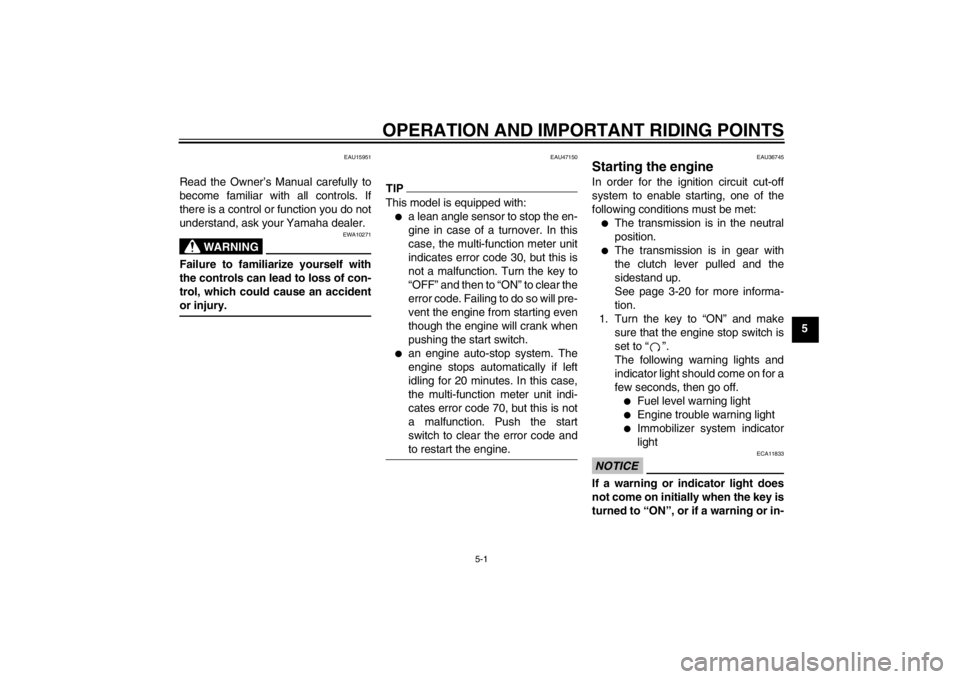
OPERATION AND IMPORTANT RIDING POINTS
5-1
5
EAU15951
Read the Owner’s Manual carefully to
become familiar with all controls. If
there is a control or function you do not
understand, ask your Yamaha dealer.
WARNING
EWA10271
Failure to familiarize yourself with
the controls can lead to loss of con-
trol, which could cause an accident
or injury.
EAU47150
TIPThis model is equipped with:●
a lean angle sensor to stop the en-
gine in case of a turnover. In this
case, the multi-function meter unit
indicates error code 30, but this is
not a malfunction. Turn the key to
“OFF” and then to “ON” to clear the
error code. Failing to do so will pre-
vent the engine from starting even
though the engine will crank when
pushing the start switch.
●
an engine auto-stop system. The
engine stops automatically if left
idling for 20 minutes. In this case,
the multi-function meter unit indi-
cates error code 70, but this is not
a malfunction. Push the start
switch to clear the error code and
to restart the engine.
EAU36745
Starting the engine In order for the ignition circuit cut-off
system to enable starting, one of the
following conditions must be met:●
The transmission is in the neutral
position.
●
The transmission is in gear with
the clutch lever pulled and the
sidestand up.
See page 3-20 for more informa-
tion.
1. Turn the key to “ON” and make sure that the engine stop switch is
set to “ ”.
The following warning lights and
indicator light should come on for a
few seconds, then go off.●
Fuel level warning light
●
Engine trouble warning light
●
Immobilizer system indicator
light
NOTICE
ECA11833
If a warning or indicator light does
not come on initially when the key is
turned to “ON”, or if a warning or in-
U1CRE1E0.book Page 1 Mond ay, October 3, 2011 8:45 AM
Page 70 of 88
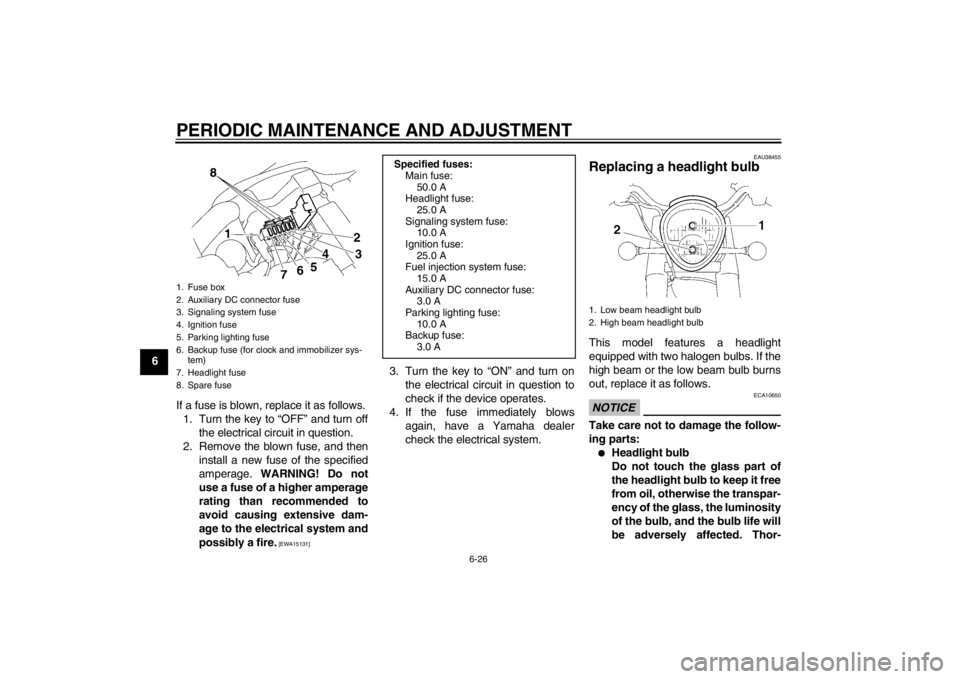
PERIODIC MAINTENANCE AND ADJUSTMENT
6-26
6If a fuse is blown, replace it as follows.1. Turn the key to “OFF” and turn off the electrical circuit in question.
2. Remove the blown fuse, and then install a new fuse of the specified
amperage. WARNING! Do not
use a fuse of a higher amperage
rating than recommended to
avoid causing extensive dam-
age to the electrical system and
possibly a fire.
[EWA15131]
3. Turn the key to “ON” and turn on the electrical circuit in question to
check if the device operates.
4. If the fuse immediately blows again, have a Yamaha dealer
check the electrical system.
EAU38455
Replacing a headlight bulb This model features a headlight
equipped with two halogen bulbs. If the
high beam or the low beam bulb burns
out, replace it as follows.NOTICE
ECA10650
Take care not to damage the follow-
ing parts:●
Headlight bulb
Do not touch the glass part of
the headlight bulb to keep it free
from oil, otherwise the transpar-
ency of the glass, the luminosity
of the bulb, and the bulb life will
be adversely affected. Thor-
1. Fuse box
2. Auxiliary DC connector fuse
3. Signaling system fuse
4. Ignition fuse
5. Parking lighting fuse
6. Backup fuse (for clock and immobilizer sys-tem)
7. Headlight fuse
8. Spare fuse
Specified fuses: Main fuse:50.0 A
Headlight fuse:
25.0 A
Signaling system fuse: 10.0 A
Ignition fuse: 25.0 A
Fuel injection system fuse:
15.0 A
Auxiliary DC connector fuse: 3.0 A
Parking lighting fuse: 10.0 A
Backup fuse:
3.0 A
1. Low beam headlight bulb
2. High beam headlight bulb
U1CRE1E0.book Page 26 Monday, October 3, 2011 8:45 AM
Page 83 of 88

SPECIFICATIONS
8-3
8
Battery:Model:GT14B-4
Voltage, capacity: 12 V, 12.0 AhHeadlight:Bulb type:
Halogen bulbBulb voltage, wattage × quantity:Low beam headlight:
12 V, 51.0 W × 1
High beam headlight:
12 V, 55.0 W × 1
Tail/brake light: LED
Front turn signal light: 12 V, 21.0 W × 2
Rear turn signal light:
12 V, 21.0 W × 2
Auxiliary light: 12 V, 5.0 W × 2
License plate light: 12 V, 5.0 W × 1
Meter lighting:
LED
Neutral indicator light: LED
High beam indicator light: LED
Turn signal indicator light:
LED
Fuel level warning light: LED Engine trouble warning light:
LED
Immobilizer system indicator light:
LED
Fuses:Main fuse:50.0 A
Headlight fuse:
25.0 A
Signaling system fuse: 10.0 A
Ignition fuse: 25.0 A
Parking lighting fuse:
10.0 A
Fuel injection system fuse: 15.0 A
Auxiliary DC connector fuse: 3.0 A
Backup fuse:
3.0 A
U1CRE1E0.book Page 3 Mond ay, October 3, 2011 8:45 AM